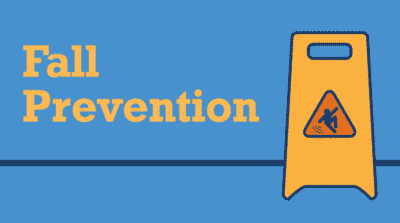Slip and fall accidents occur year round and can happen anywhere: work, home, or just out on the town. In fact, over 8 million people visit the emergency room every year to treat injuries caused by fall-related incidents, according to the National Floor Safety Institute (NFSI). These types of accidents are the leading cause of hospital visits across the country and can result in permanent or even fatal injuries if the conditions of the fall are serious enough.
National Fall Prevention Month
When you think of deadly accidents, most think of vehicle crashes or incidents involving dangerous machines. However, fall accidents can be just as deadly. In just one year, slip, trips, and falls contribute to approximately:
- 12,000 occupational fatalities (OSHA).
- 30,000 fatalities of people over the age of 65 (AARP).
- 150 child fatalities (Safe Kids Worldwide).
In addition, millions of people of all ages sustain nonfatal injuries from fall-related accidents that sometimes result in permanent disabilities or catastrophic losses.
To help spread awareness on the dangers of fall-related accidents, September is known as National Fall Prevention Month. This safety campaign aims to educate people on the most common causes of slips, trips, and falls, as well as how they can help prevent these accidents to reduce the number of injuries and fatalities that could occur.
Two Types of Fall Accidents
When it comes to accidents involving a fall, there are two main types: falls from elevation (40% of slip and fall cases) and falls from the same level (60% of slip and fall cases). Both of these can cause serious or even fatal results, which is why everyone needs to be aware of the hazards to look out for to help prevent a disaster.
- Elevated Falls: Falls from elevation are less common than same level falls, but injuries can be far more severe in these instances. Elevated falls occur most often in occupational environments where workers are at a higher risk of injury due to their job requirements. The most common elevated fall accidents highlighted by the National Ag Safety Database (NASD) include:
-
- falls off ladders or unsteady platforms
- falls from vehicles or equipment
- falls off loading docks
- falls down stairs
- Same Level Falls: Fall accidents on same level surfaces are the most common type of fall injuries. There are numerous hazards that could cause someone to fall and injure themselves simply by walking to down the street, the most common being:
-
- slippery floors or slick walking surfaces
- dry floors with wood dust or powder
- clutter/obstacles in common walking areas
- inadequate lighting in common walking areas
- loose flooring
- uneven walking surfaces
- weather-related hazards (ice, snow, rain)
- stationary obstacles on the street (garbage cans, benches)
- shopping carts, strollers, or other large pushing devices
Lucky individuals who survive any of these fall hazards, both elevated and on the same level, may only walk away with a few bruises and a damaged ego. But for others, slip and falls can completely alter their lives.
Most Common Fall Injuries
Injuries that result from fall accidents range from minor to severe, to fatal. Depending on the type of fall, the age of the individual, and any preexisting health conditions, NASD reports victims of slip and fall accidents can suffer a variety of injuries, including:
- back injuries
- joint damage in the wrist, elbow, or shoulder
- joint damage in the ankle, knee, or hip
- broken bones and fractures
- sprains and strains
- lacerations and bruising
- traumatic brain injury
- spinal cord damage
- death
Back injuries are the most common of all fall injuries, contributing to 37% of all elevated falls and 29% of all same level falls in the United States. An article published by Health Link BC identifies multiple back conditions victims of fall accidents could endure:
- back strains or sprains
- tearing of the back muscles and ligaments
- overlapping of the vertebras on the spinal column, triggering misalignment.
- pinched of nerves
- damaged bones, muscles, cartilage or tendons surrounding the spine.
- ruptured discs
- vertebral fracture
- paralysis
Victims of fall accidents cannot always predict when they are about to sustain a fall injury- otherwise, they would choose not to! Prevention and preparation is the most effective method for reducing the number of fall accidents that can occur in all environments, including in the home, workplace, and public spaces.
Preventing Falls At Home
For individuals who are prone to falling in their own homes, it’s extremely important to fall-proof all common areas to help prevent the risk of unnecessary injuries. Push Button Emergency Help (PBEH) recommends taking the following steps to make your home safer:
- Remove tripping hazards inside (toys, clothes, doors, clutter, laundry baskets, bags) outside (garden hose, bikes, furniture).
- Add extra lighting to walking paths (nightlights and permanent lighting).
- Make stairs safe (remove clutter, smooth carpet, replace loose boards and screws).
- Install grab bars if needed for balance on stairs, outside, or in the bathroom.
- Use non-slip rugs and surfaces in the kitchen, bathroom, or other rooms with slick floors.
Preventing Falls At Work
Falls at work can be extremely dangerous, particularly on construction sites and in warehouses full of hazardous machines and materials. Grainger recommends following these guidelines for creating a safer workplace to prevent fall accidents:
- Assign housekeeping: Get all employees on board with keeping their work areas clean and tidy, putting away tools when done and keeping machines out of walking paths.
- Reduce slippery surfaces: Reduce wet or slippery surfaces on sidewalks, parking lots, food preparation areas by keeping them clean, providing cleaning materials for spills nearby, or other materials to soak up liquids and grease.
- Avoid obstacles in aisles: Clear cords, cables, hoses, boxes, cabinets, briefcases, and all other hazards out of walking aisles.
- Proper lighting: Make sure all areas of the workplace are lit appropriately for the time of day workers are performing their jobs.
- Wear proper footwear: Wear shoes with effective traction and protective toes to meet the needs of the job you are performing.
- Control employee behavior: Address any untidy behavior that could lead to employees falling immediately before it gets out of hand.
Preventing Falls In Public
There is little you can do about preventing the occurrence of hazards out in public, but being aware and prepared for these obstacles can help prevent fall accidents. Residents out and about should always look out for:
- liquid or grease spills
- uneven or cracked sidewalks
- unexpected curves
- change in elevation
- stairs
- other pedestrians
- small children
- dogs on leashes
- strollers and wheelchairs
- stationary garbage cans and benches
Other helpful tips to avoid slip and fall injuries out in public are to wear shoes appropriate for the conditions you are walking in, bring assistive devices for walking if needed, and avoid distractions while walking (cell phones, headphones, reading materials, etc.)
Long Island Slip and Fall Experts
Injuries sustained from slip and fall accidents can be life-changing and devastating, especially when it’s obvious that the accident could have been prevented. There is no excuse not to clear hazards and make facility repairs to prevent others from getting hurt. Our winning team at Siler & Ingber has been fighting back for victims of unnecessary slip and fall injuries on Long Island for over 25 years. If you or a loved one has been injured in a slip and fall accident due to the negligence of another, call 1-877-LAW-4343 for a free case evaluation to explore your options for justice.

The Impact Of Marijuana Legalization
Would New York legalizing recreational marijuana increase road accidents? We took a look at the stats in our latest study.
View StudyThe Law Office of Siler & Ingber, LLP
Phone:
1.516.294.2666
Address:
301 Mineola Blvd. Mineola, NY 11501
Subscribe to our Newsletter
SubscribeThis is a unique website which will require a more modern browser to work!
Please upgrade today!

